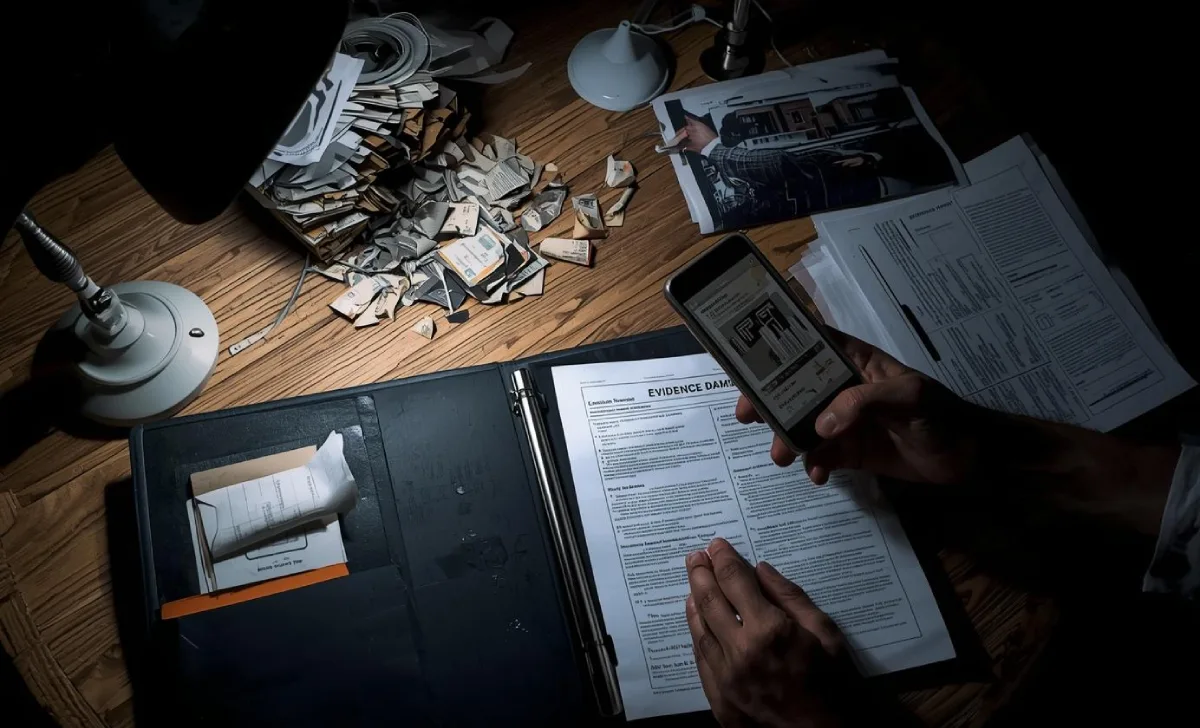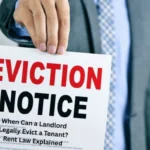When your landlord is not repairing property in Australia, you’re not powerless. Australian tenancy laws give you strong rights to live in a safe, well-maintained rental property. Whether it’s a leaking roof, broken hot water system, or faulty electrical wiring, landlords have clear legal obligations to maintain their properties.
- Quick checklist: is this a repair the landlord must do?
- Evidence-first checklist — photos, timestamps, logs and third-party reports
- How to ask for repairs — sample emails, scripts and good timing
- Template A — First repair request (copy-paste ready)
- Template B — Final written notice before escalation (copy-paste ready)
- Tribunal pathways by state — how to escalate landlord not repairing property Australia disputes
- Preparing your tribunal application & hearing — structure, evidence exhibits and tips
- Remedies, compensation and enforcement — what tribunals can order & how to enforce orders
- FAQs
- Take action now — your repair rights matter
This step-by-step guide shows exactly what to do when repairs aren’t happening. You’ll learn how to gather bulletproof evidence, use proven communication templates, and navigate your state’s tribunal system to get repairs completed or claim compensation. Don’t suffer in silence — here’s how to take action.

Quick checklist: is this a repair the landlord must do?
Not every maintenance issue falls on your landlord’s shoulders. Understanding the legal thresholds helps you focus your energy on winnable cases.
Landlord responsibilities: include structural repairs, plumbing and electrical systems, heating and cooling appliances provided with the tenancy, and safety equipment like smoke alarms. These are considered essential services that affect your health, safety, or security.
Tenant responsibilities: typically cover accidental damage you caused, minor maintenance like changing light bulbs or air filters, and wear-and-tear items like batteries in smoke detectors.
| Urgent repairs (call immediately) | Non-urgent (use written request) |
|---|---|
| Gas leaks, electrical faults | Dripping taps, minor wall cracks |
| No hot water system | Peeling paint, squeaky doors |
| Blocked toilet (only toilet) | Broken cupboard handles |
| Roof leaks, structural damage | Garden maintenance issues |
| Broken locks on external doors | Cosmetic bathroom repairs |
Response timeframes: Urgent repairs typically require immediate action or within 24 hours, while non-urgent repairs usually allow 14-28 days depending on your state’s legislation.
For comprehensive information about your specific rights, check out which covers repair obligations in detail across all states.
Evidence-first checklist — photos, timestamps, logs and third-party reports
Strong evidence wins tribunal cases. Before making any repair requests, document everything thoroughly. This approach maximises your chances of success if the matter escalates to a formal dispute.
Your evidence arsenal should include visual proof, written communications, and third-party validation. Each piece serves a specific purpose in building your case at tribunal.
Photos & video
Take photos immediately when you notice damage. Use your phone’s timestamp feature and include reference objects for scale — a ruler, coin, or everyday item like a coffee mug works perfectly.
Capture multiple angles: wide shots showing the entire room or area, medium shots showing the problem in context, and close-ups highlighting specific damage. For water leaks, photograph any resulting damage to furniture, carpets, or personal belongings.
Video evidence proves ongoing issues like intermittent electrical faults, strange noises, or water flow problems that photos can’t capture effectively.
Written requests & repair log
Every repair request must be in writing — texts, emails, or formal letters all count. Keep copies of everything and note response times.
Create a simple repair log using this format:
- Date: 2025-09-15
- Issue: Kitchen tap leaking
- Action requested: Replace washer/tap
- Landlord response: No response 2025-09-18
This chronology becomes crucial evidence if you need to prove the landlord’s delay or non-response patterns.
Receipts, quotes & expert statements
Collect repair quotes from licensed tradespeople, especially for urgent repairs. If you paid for emergency repairs yourself (which tenancy law sometimes allows), keep all receipts.
For complex issues like structural problems or electrical faults, consider getting a brief written statement from a qualified professional explaining the safety risks or required repairs.
How to ask for repairs — sample emails, scripts and good timing
Written repair requests create a legal paper trail and demonstrate you followed proper procedures. Use these proven templates to communicate professionally while protecting your rights.
Always send repair requests via email for automatic timestamps and delivery confirmation. Follow up phone calls with written summaries: “As discussed on [date], you agreed to…”
Template A — First repair request (copy-paste ready)
Subject: Repair Request - [Property Address] - [Brief Issue Description]
Dear [Landlord/Agent Name],
I am writing to formally request repairs at [property address] where I am the tenant under lease dated [lease date].
Issue: [Describe the problem clearly - e.g., "The bathroom ceiling has a water leak causing brown staining and dripping water"]
Safety/urgency: [If applicable - e.g., "This poses a slip hazard and potential electrical risk"]
I have attached photos documenting the issue and request this repair be completed within [14 days for non-urgent / immediately for urgent repairs] as required under tenancy legislation.
Please confirm receipt and your repair schedule.
Kind regards,
[Your name]
[Date]
Photos attached: [List what you're attaching]
Template B — Final written notice before escalation (copy-paste ready)
Subject: FINAL NOTICE - Unresolved Repair Issue - [Property Address]
Dear [Landlord/Agent Name],
I refer to my previous repair requests dated [dates] regarding [issue] at [property address].
Despite [X days/weeks] passing, this repair remains incomplete. Under [State] tenancy legislation, landlords must maintain rental properties in good repair.
I require this repair completed by [specific date - usually 7 days]. If not resolved, I will lodge a dispute with [relevant tribunal name] seeking:
- Orders to complete repairs
- Compensation for inconvenience
- Reimbursement of costs incurred
Please confirm immediate action.
[Your name]
[Date]
Pro tip: Send these templates via email and keep screenshots of “delivered” confirmations.
These templates work alongside the repair guidance in for comprehensive repair request strategies.
Tribunal pathways by state — how to escalate landlord not repairing property Australia disputes
Each Australian state and territory has specific tribunals handling tenancy disputes. Here’s exactly where to go and what to expect:
| State | Tribunal | How to Apply | Typical Timeframe |
|---|---|---|---|
| NSW | NCAT | Online application + $50 fee | 4-6 weeks |
| VIC | VCAT | Online/postal application + $62.40 fee | 6-8 weeks |
| QLD | QCAT | Online application + $45.95 fee | 4-6 weeks |
| WA | Magistrates Court | Written application + $71 fee | 8-12 weeks |
| SA | SACAT | Online application + $49.50 fee | 6-8 weeks |
| TAS | Residential Tenancy Commissioner | Free application online | 2-4 weeks |
| ACT | ACAT | Online application + $52 fee | 4-6 weeks |
| NT | NT Civil & Administrative Tribunal | Written application + $154 fee | 6-10 weeks |
NSW: Apply through NCAT online portal. Bring evidence bundle, repair quotes, and communication records. Hearings typically last 30-60 minutes.
Victoria: VCAT accepts online applications with digital evidence uploads. Consider mediation options before formal hearings.
Queensland: QCAT offers dispute resolution services. Lodge complaints through their online portal with supporting documents.
Western Australia: Apply to Magistrates Court Small Claims Division. Written applications preferred with comprehensive evidence attachments.
South Australia: SACAT provides free dispute resolution services initially, then formal hearing options if mediation fails.
Tasmania: The Residential Tenancy Commissioner offers free applications and relatively quick resolution times.
ACT: ACAT handles tenancy disputes with user-friendly online application processes and digital evidence submission.
Northern Territory: Applications to NT Civil & Administrative Tribunal require detailed written submissions and evidence bundles.
For specific application forms and procedures, visit your state’s consumer affairs website or contact your local for free application assistance. 
Preparing your tribunal application & hearing — structure, evidence exhibits and tips
Strong tribunal applications follow a logical structure: statement of facts, chronological timeline, numbered exhibits, and specific remedies sought.
Application structure:
- Statement of facts: Brief summary of the tenancy, repair issue, and attempts to resolve
- Chronology: Date-ordered timeline of events, communications, and responses
- Evidence exhibits: Numbered documents supporting your case
- Remedy sought: Specific orders you want the tribunal to make
Exhibit index template:
- Exhibit 1: Photographs of damage (with timestamps)
- Exhibit 2: Repair quotes from licensed tradespeople
- Exhibit 3: Email correspondence with landlord/agent
- Exhibit 4: Receipts for emergency repairs (if applicable)
- Exhibit 5: Expert statements or inspection reports
Hearing day tips: Arrive 15 minutes early with printed copies of all exhibits. Prepare a 2-minute summary of your case focusing on key facts, not emotions. Dress professionally and speak directly to the tribunal member, not your landlord.
Rehearse answering likely questions: “When did you first notice the problem?”, “What attempts did you make to contact the landlord?”, “What remedy are you seeking?”
Remedies, compensation and enforcement — what tribunals can order & how to enforce orders
Australian tenancy tribunals have broad powers to resolve repair disputes and compensate tenants for landlord failures.
Typical remedies include:
- Repair orders: Directing landlords to complete specific repairs within set timeframes
- Monetary compensation: Refunding rent for periods when facilities were unusable
- Emergency repair reimbursement: Ordering landlords to repay tenant-funded urgent repairs
- Rent reduction orders: Temporarily reducing rent until repairs are completed
Enforcement mechanisms vary by state but typically include:
- Warrant for seizure and sale: The Sheriff can seize landlord’s assets to satisfy unpaid orders
- Garnishee orders: Direct deduction from landlord bank accounts or wages
- Contempt proceedings: Penalties for ignoring tribunal orders
Timeframes for enforcement usually range from 28-60 days after the order is made. Most landlords comply voluntarily to avoid escalated enforcement action.
If your landlord ignores tribunal orders, contact your state’s enforcement unit immediately. Don’t wait — enforcement becomes harder as time passes.
FAQs
Can I repair and deduct costs from rent?
Only for urgent repairs in most states, with strict procedures and spending limits. Check your state’s tenancy laws first.
How long does it take to get a tribunal order?
Typically 4-8 weeks from application to hearing, depending on your state’s tribunal backlog.
What if my landlord shuts off utilities during a dispute?
This is illegal in all states. Contact your local tenancy advice service and consider emergency tribunal applications.
Do I need a lawyer for tribunal hearings?
No. Tribunals are designed for self-representation, though free legal advice beforehand can be helpful.
Can I be evicted for requesting repairs?
No. Retaliatory evictions are prohibited. Document any eviction notices received after repair requests.
What if the repair estimate exceeds the rental bond?
Tribunals can order compensation beyond bond amounts and direct landlords to pay additional costs.
Take action now — your repair rights matter
When your landlord is not repairing property in Australia, you have clear legal pathways to resolution. Start with thorough evidence collection using the checklist above, then send formal written repair requests using the provided templates.
If repairs still aren’t completed, don’t hesitate to lodge tribunal applications. Australian tenancy tribunals consistently support tenants who follow proper procedures and present strong evidence.
Remember: you pay rent for a habitable property. Your landlord’s repair obligations aren’t optional — they’re legal requirements you can enforce through proper channels.
Next steps: Download the evidence checklist, photograph any current property issues, and send your first repair request email today. For ongoing support, contact your state’s tenants’ union or Fair Trading office for free advice tailored to your situation.






